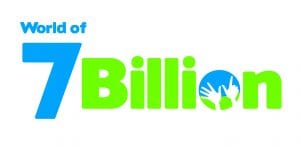 Hopefully, you’ve already thought about how you will incorporate the World of 7 Billion student video contest into your classes. Whether you’re teaching Social Studies, Science, AP Human Geography, AP Environmental Science, Global Studies, Civics, Economics, or Communications classes, the contest can help you discuss real-world, relevant, global issues that will be impacting your students for the rest of their lives.
Hopefully, you’ve already thought about how you will incorporate the World of 7 Billion student video contest into your classes. Whether you’re teaching Social Studies, Science, AP Human Geography, AP Environmental Science, Global Studies, Civics, Economics, or Communications classes, the contest can help you discuss real-world, relevant, global issues that will be impacting your students for the rest of their lives.
Here’s the challenge:
There are over 7 billion people sharing the planet and we live in an increasingly connected world. In our global society, population pressures can affect our ability to sustainably use the earth’s resources and improve living conditions for all of the world’s people. Considering the interdependence of people and the planet, create a short video (60 seconds or less) that illustrates the connection between population growth and one of the following global challenges: climate change, global poverty, or water sustainability.
And here’s an overview of the three choices of global challenges:
Climate Change: Over the past century, the earth’s average temperature has risen by 1.4°F, causing climate changes that affect our health, environment, and economy. And although 1.4°F may not seem like a substantial increase, it causes shifts in the earth’s long-term climate patterns. Currently, our planet is experiencing more flooding, stronger heat waves, more frequent droughts, and more intense hurricanes as well as glacier melting and sea level rising, than it has in the past. Because climate change is linked to many human activities, population growth will likely only exacerbate these problems.
Global poverty: Roughly 1.2 billion members of our global family live in poverty, or on less than $1.25 per day. Poverty is linked to many global issues, including undernourishment, poor public health, and even issues relating to climate change. The causes of poverty are complex, and many poor communities across the world find themselves stuck in the “poverty trap”—a reinforcing cycle that enables poverty to persist across generations.
Water sustainability: Currently, 1.1 billion people around the world lack access to safe drinking water, and 2.6 billion do not have access to basic sanitation. At the same time, water consumption increased at twice the rate of population growth over the past century and we see developed countries using much larger quantities of water per capita than people in the developing world. But across the board, this growing demand for water means that by 2025, the number of people without access to safe water may increase to 1.8 billion and two-thirds of the global population could be living in water-stressed areas.
Find out even more with our suggested Research Resources.




